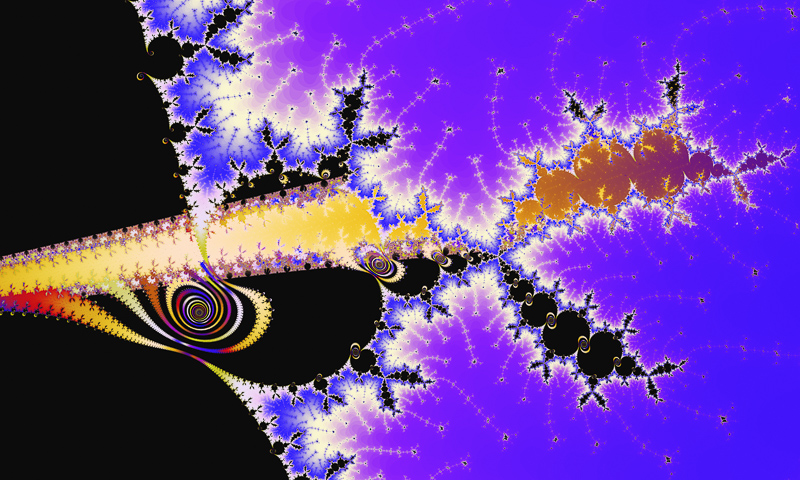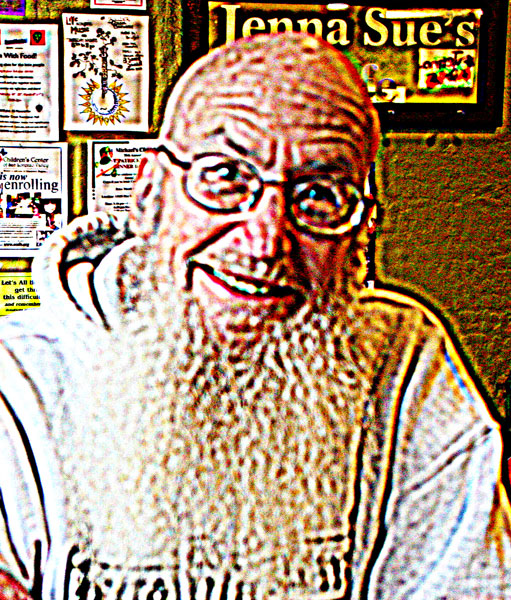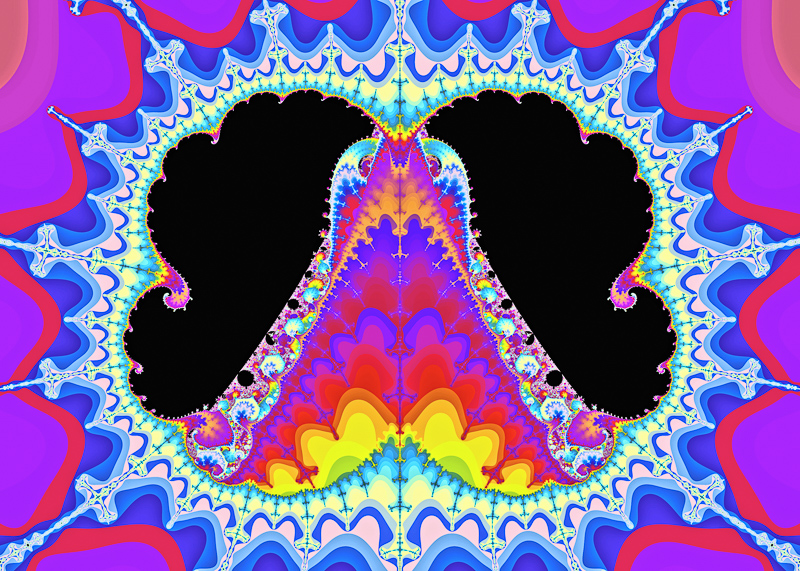Some comments by Ted Chiang, Benjamin Rosenbaum, Nathaniel Hellerstein and others in my recent post on “True Names and Fnoor” got me to thinking about the relationships between science fiction and quantum mechanics. This is a big topic, so I’m going to break it up into two or possibly more posts.
First, a throwaway remark—a chemist friend of mine once remarked that it would be entertaining if fundamentalist religious types got into attacking quantum mechanics. They’re always just hammering way on evolution, I guess because it’s fairly easy to (sort of) understand. Certainly there are some things in QM that might stoke someone’s ire. If the Lord knows all things, how dare scientists assert that the universe is in any respect Uncertain?
Do keep in mind that QM does have its good side. One key point, which Ted hinted at, is that the very stability of matter seems to depend upon QM. I’m thinking here of the notion of there being minimum amounts of energy (quanta) by which a system can change. Consider an electron orbiting a proton—a hydrogen atom, in other words. If energy weren’t quantized, the electron would gradually spiral in to the proton, and the atom would collapse. But, as things stand, an undisturbed hydrogen atom is very unlikely to pulse out the full quantum of energy necessary for a collapse. In some sense, QM acts as a set of struts to prop up our atoms.

[RudyParticleBeam. Dig this yottawatt particle beam projector that I found inside the Rudy Set this week. All digital, all deterministic. If you have a fat pipe and want to appreciate the true freakin’ weirdness of this mathematical object (based on the seemingly innocent notion of cubing a complex number) here’s a 4 Meg image of RudyParticleBeamthat’s 3000 pixels wide. Get in there and wallow in it, dog. ]
But for an SF writer, there are a number of things about QM that are provocative. I have six little subpost sections in mind; I’ll cover the first three of them today and the last three in a follow-up post.
(1) Under the Quantum Foam: Does space break down at a small enough scale?
(2) Many Universes? Some think that QM supports a multiverse in which our universe is only one of an endless set of variations.
(3) Yes and No. The QM notion of superposed states says that systems (like the famous Schrödinger’s Dead Horse…I mean Cat) can be in several seemingly exclusive states at the same time.
(4) The Secret Theory. Can there be hidden variables and a deterministic theory at a deeper level than QM?
(5) QM Teep. The QM notion of entanglement says that distant particles’ states are in some instantaneous way correlated.
(6) Everything’s Alive. Quantum computation indicates that any piece of matter can be regarded as a supercomputer, potentially cabable of carrying out intelligent-seeming computations.

1. Under the Quantum Foam.
The notion of quantum graininess spills over from energy and into space and time. One often hears talk of the so-called Planck length, which is about 0.000 000 000 000 000 000 000 000 000 000 000 001 616 meters, or a hundred-quintillionth the size of a proton. This particular distance pops out of the mathematics of QM. There’s a common feeling that the whole notion of space might not work anymore at the Planck length size scale—you often hear the phrase “quantum foam” (scroll to the end of this page, for instance).
What’s not to like about quantum foam? Well, you can of course capitalize on it, and blend it into your story. I don’t think I’ve seen enough stories like that. The physicist George Gamow made some popular attempts at this kind of thing in his beloved Mr. Tompkins books, here’s an excerpt of one. In my own novel, Master of Space and Time, the gimmick that I used for giving my characters a fleeting ability to control the universe was to locally (in the vicinity of their heads) expand the Planck length into a one-meter length.——
But if you’re interested in having some kind of “scale ship” that lets people shrink down endlessly into the microverse, then the foam is a problem. I wrote a novel about this, too, Spacetime Donuts—in this book, I pretty much punted on the problem with QM and just glossed it over. My characters shrank all the way down to the smallest possible level and, gloryoski!, the smallest level was the same as the largest, so they ended up shrinking down to find the same Earth they’d left from. Very Golden Age.

[Interlude: This is my recent painting, “First Contact,” oil, 40” by 30”. More info on my paintings page.]
A few years ago, I found a heartening passage in Michio Kakau, Parallel Worlds, where Kakau discusses a 1984 theory of “string duality” ascribed to Keiji Kikkawa and Masami Yamasaki. String duality theory also allows for interesting physics below the Planck length. The Planck length becomes something like an interface between two worlds. As Kakau puts it:
“Let’s say we take a string theory and wrap up one dimension into a circle of radius R. Then we take another string and wrap up one dimension into a circle of radius 1/R. By comparing these two quite different theories, we find that they are exactly the same. Now let R become extremely small, much smaller than the Planck length. This means that the physics within the Planck length is identical to the physics outside the Planck length. At the Planck length, spacetime may become lumpy and foamy, but the physics inside the Planck length and the physics at very large distances can be smooth and are in fact identical.”
I decided to start using the word “subdimensional” for the cosmos that lies “inside the Planck length.” It’s kind of a Golden Age term of uncertain meaning, but I started using it in the sense of string duality theory (without saying so) in my Flurb story with Paul DiFilippo, “Elves of the Subdimensions.” I also used this idea in my Tor.com story, “Jack and the Aktuals.” And I used the subdimensional world in my novels Postsingular and Hylozoic—here there are some nasty beings called subbies living down there. I put it like this Postsingular.
“Did you guys see that weird ocean when you came across?” Thuy asked Ond.
“I think it’s the Planck frontier,” said Ond. “Physics at the scales smaller than the Planck length is supposed to be identical to physics at the scales larger than the Planck length. So then the Planck length is a frontier between dual versions of the cosmos. And if someone shrinks down into the dimensions under the foamy frontier, they’ll feel like they’re expanding into a whole alternate cosmos hidden in the subdimensions. There’s a world under that ocean.”
“A subdimensional world,” said Chu. “We’re heard the Hibraners taking about it. They call it Subdee. And those bird-headed men we saw were subbies. Subbies from Subdee.”

2. Many Universes?
In the essay on infinity, “Avatars of the Tortoise,” that appears in his collection Labyrinths, Jorge Luis Borges writes, “This is a concept which corrupts and upsets all others. I refer not to Evil, whose limited realm is that of ethics; I refer to the infinite.”
To my way of thinking, Borges dictum is equally true of “the multiverse.” I don’t think I’ve ever seen¬ an SF novel or story the full quantum-mechanical multiverse with complete success. What tends to happen in these tales is that the character moves along some sequence A1 of events until *wham* something’s about to kill him or her and then *hop* the character jumps over to a sequence A2 of events where all is well.
My problem with this is that the narrative then is a kind of cheating. There’s no essential connection between A1 and A2, that is, there is no causal connection between these two. They’re two independent histories, and it’s wishful thinking to pretend that there is some higher-level metacharacter who is able to move from the one to the other. I discuss this in more detail with reference to Neal Stephenson’s excellent novel Anathem, in my post, “Narratives in the Multiverse.”

Let me back up a bit. What QM have to do with the multiverse anyway? Although there is no QM axiom or principle that explicitly decrees randomness, the conventional belief is that many primitive events (such as the decay of a radioactive atom) do in fact happen randomly. (One reason this isn’t an axiom is because the precise meaning of “random” is, in a Goedelian and metamathematical sense, impossible to define.)
IN any case, many of us would like to suppose that our reality is in no sense random, and that things don’t happen for no reason at all. A sloppy way to account for the seeming randomness of low-level quantum events seem to be random is to insist that the timeline of our universe is continually branching, and that, for lack of a better reason to go one way or the other, both outcomes result from any up-or-down measurement. And the universe splits, and a copy of you goes into each universe
I think this is a terrible idea. As I write in my tome, The Lifebox, the Seashell, and the Soul:
“Many people find the multiverse model philosophically unsatisfying. It’s hard to put one’s finger on the problem, but I think it has to do with meaning. One likes to imagine the world has an ultimate explanation of some kind. Call it what you will: the Secret of Life, God’s Plan, the Theory of Everything, the Big Aha, whatever. If we live in a multiverse of many universes, then perhaps the multiverse has a Multiversal Big Aha, but a mere individual universe doesn’t get a Big Aha. An individual universe is simply the result of an incalculable number of coin flips. To me, this feels inane and defeatist. Our beautiful universe deserves a better explanation than that. Although the multiverse model is in fact useful for understanding certain kinds of quantum phenomena, it’s not attractive as a final answer.”
Note that QM does not require us to have a multiverse. We can instead accept that systems enter superposed mixtures of “both up and down” states, and that the process of observation precipitates such a system (randomly?) into one particualr pure state.

A few more words on alternate worlds. What I do think to be feasible for an SF story is to work with some limited number of branes, or alternate universes, and to have characters moving from one brane to the other. When they move they might possibly encounter alternate copies of themselves, although it’s often convenient to eliminate the alternate self in some fashion (that is, either the alternate is dead, or perhaps the alternate has left for yet another brane). I used this technique in my novel Mathematicians in Love—here there is a jellyfish-like “God” who creates a new “draft” of our universe on every Friday, and my main characters manage to hop to a sequence of maybe three alternate drafts.

A different idea about multiple universes or branching time is implicit in the notion of “precogs,” that is, psychically gifted people who can continually select the optimal thing to do next. I think the very first Phil Dick story I ever read was a fine exemplar of this: “The Golden Man,” about a guy who is unkillable because he always knows to zig when you zag.
To do this right we want to avoid assuming all the futures are real—because, once again, if all the futures are real, then it means nothing to claim that someone always picks the right path because he or she is continually picking every path. This claim is as spurious as a stock broker ad that shows a protracted series of different people making money on stocks…and which tries to pretend that all those people are one and the same person…who could be you, ’cause you’re Younique!
To some extent we do look into possible futures—that’s what reasoning and imagining scenarios is all about. But to give it an SF twist, let’s suppose that, although our timeline doesn’t fully branch, it does very commonly grow out stubs that are some fractions of a second long. If the one undivided history of our one world doesn’t enter a stub, then it withers and snaps off . Or you might say that the history might even go a little way into a bad branch but then somehow back up like a car out of a dead-end alleyway, and head back on the “proper” branch. The backups are very common, in fact they’re all but ubiquitous.
Most people don’t notice this, as when time backs up, events run backwards and memories get erased. But our Golden Man or Woman does learn to notice. And you need to put some thought into what happens when A and B stand at a crossroads and differ about which is to be the path taken.

[Another recent painting by me, “Werewolf,” oil, 20” by 16”]
3. Yes and No
QM famously says that, left on their own, systems evolve into so-called superposed states which are a mixture of classically different states. But when an “observer” examines a system it quick-as-a-flash “collapses” into being some pure, non-mixed, non-superposed state.
Another pair of words used here are coherent and decoherent, taken in a technical QM sense where “coherent” means a mixed or superposed state, and “decoherent” is a prissy, flattened-out, one-thing-and-one-thing-only pure state.
The notion of “coherent,” “superposed,” or “mixed” states is one of things that seems superficially very remote from ordinary life. But, if you ponder it, you may come to see that in some respects our minds are very often in superposed states. Do I like this meal? Well, until you insisted on an answer, I didn’t have a real opinion about it…

Here’s a quote from a thought-provoking article by Nick Herbert called “Quantum Tantra”. He’s leading up to a proposal that our mind is, as I’m hinting, very much like a quantum system that naturally evolves into superposed states.
“By the high standards of explanation we have come to demand in physics and other sciences, we do not even possess a bad theory of consciousness, let alone a good one. Speculations concerning the origin of inner experience in humans and other beings have been few, vague and superficial. They include the notion that mind is an ‘emergent property’ of active neuronal nets, or that mind is the ‘software’ that manages the brain’s unconscious ‘hardware’… Half-baked attempts to explain consciousness, such as mind-as-software or mind-as-emergent-property do not take themselves seriously enough to confront the experimental facts, our most intimate data base, namely how mind itself feels from the inside.”

Nick proposes that we think of the human mind as a quantum system. Recall that quantum systems are said to change in two ways: when left alone, they undergo a continuous, deterministic transformation though a series of superposed states, but when observed, they undergo abrupt probabilistic transitions into pure, classical states. Nick suggests that we can notice these two kinds of processes in our own minds.
(Coherent) The continuous evolution of quantum superpositions corresponds to the transcendent sensation of being merged with the world, or, putting it less portentously, to the everyday activity of being alert without consciously thinking much of anything. In this mode you aren’t deliberately watching or evaluating your thoughts.
(Decoherent) The abrupt transition from mixed state to pure state can be seen as the act of adopting a specific opinion or plan. Each type of question or measurement of mental state enforces a choice among the question’s own implicit set of possible answers. Even beginning to consider a question initiates a delimiting process.
[This discussion of Nick’s idea is drawn from The Lifebox, the Seashell, and the Soul. And I also talked about this in a 2005 blog post.]

[Image of RudySplitBrain, see the Rudy Set post for details about how to do this to your own head at home. I have to mention that my recent, and still ongoing, relapse into fractal-mania is getting into my dreams—last night I was wading at a seaweed-filled ocean beach, and the stuff in the water was high-order fractals beyond gnarl. And this is a good thing.]
I’ll get into a discussion of hidden variables as, (4) The Secret Order, of entanglement as (5) QM Teep , and of quantum computaion as (6) Everything’s Alive. — in a later post, to be called “SF and Quantum Mechanics #2.”









May 4th, 2010 at 6:26 am
I like the paintings, also the idea of fnoor. You’re onto something, as usual!
May 4th, 2010 at 7:53 am
Wow, what a rich post. It seems in some ways reminiscent of Life Box, and Infinity and the Mind for that matter. I suppose those unanswerable questions don’t really go away.
There must be isomorphic models of orbitals that have different explanations for why they don’t collapse. Maybe the idea of energy leaking away is broken in a way that our macroscopic brains just can’t fathom. Or maybe an equally valid model is that energy is being pumped into the electron all the time. (I can’t make sense of those either.)
Whenever I think about these things I keep coming back to the realization that I don’t really know what we mean by dimension. (I understand the idea of orthogonality, but somehow this isn’t what is in my intuition.) What the heck could it mean for dimensions to have different sizes? Could you know that dimensions had different sizes from within the system?
The view of QM that I’ve been leaning towards lately — because none of them make as much or any sense — is that the collapse is a fiction of the brain. Another idea I have is that somehow most of the possible universes are in fact rather improbable and that they fade, maybe the disappear into some sort of round off error:-). These can kind of fit together with the idea that the brain is actually noticing the narrowing of probable universes. But I don’t think I’ve ever heard of a mathematically defensible notion like this that is not complete conjecture — like round off error.
Of course the universe we are in is horribly improbable already, so improbable that we wonder how even God-if-there-is-a-God could pull it off. This of course, very quickly, leads to anthropomorphic speculations, history working back through time, etc. But these don’t seem to appeal to you as much as they do me.
Anyway, be well and don’t let the subbies get ya.
May 4th, 2010 at 10:39 am
“Many people find the multiverse model philosophically unsatisfying … If we live in a multiverse of many universes … An individual universe is simply the result of an incalculable number of coin flips. To me, this feels inane and defeatist.”
I have to disagree. As a scientist you don’t pick the model that feels the most satisfying, you pick the model that best matches the available data. If we are choosing based on what feels best, why not just go for a universe with a friendly god sitting in heaven?
To me, the reason the multiverse interpretation of QM makes sense is because its the only model that does not ascribe magical powers to the so-called ‘Observer’. Since I believe that human consciousness is an emergent product of normal matter, I don’t believe the mind can cause whole sections of the universe to disappear simply by choosing to look one way or another (e.g. the many Schrödinger’s cat type paradoxes).
I agree it is frustrating to imagine that we a limited to an infinitesimal slice of a much larger multiverse, but to me this makes the most sense. Why should our chimpanzee brain be able to comprehend the true majesty of the multiverse any better than a dog can understand astrophysics?
May 4th, 2010 at 3:11 pm
Felix, I don’t really object to the idea of there being a number of other universes, indeed this seems fairly likely. And I agree that we are only seeing a tiny part of the whole, sometimes I think of water-striders in a tiny inlet in a great lake.
What I take exception to is the notion of a maximal multiverse in which EVERY possible universe exists. And we just so happen to be in this particular and very nice one. Nowhere in nature do we see every possible version of something existing, there are always principles of selection and weeding-out processes at work.
To trot out an old chestnut from the philosophy, there is a sense in which a solid block of marble contains the Venus Aphrodite, as well as every other sculpture. But in and of itself the block is just a block. One feels that someone or something has to carve the models. Or, yet again, if you want to read a novel, you’re not satisfied if someone gives you a set of Scrabble letters and tells you to keep drawing until you happen upon a booklength stretch of words.
I would maintain that the feel and the aesthetics of a theory is very much something that most scientists and philsophers care about. In principle there really are endlessly many theories that would fit any given set of facts, and we like to find theories which are concise and elegant.
We still have the question of how to fit together the continuous evolution of probability waves with the seemingly abrupt changes that we associate with observation. But I think there are subtler or odder ways to understand this than by jumping to a maximal multiverse model. Think of complemenarity, duality, or a self-observing universe…
May 4th, 2010 at 5:54 pm
@ Felix –
You wrote: ‘To me, the reason the multiverse interpretation of QM makes sense is because its the only model that does not ascribe magical powers to the so-called ‘Observer’. Since I believe that human consciousness is an emergent product of normal matter, I don’t believe the mind can cause whole sections of the universe to disappear simply by choosing to look one way or another.’
No. ‘Observation’ absolutely does _not_ entail or require a ‘conscious observer’ with magical powers. It’s the exchange of quantum information _only_ that brings wavefunction collapse. Better to think of ‘the measurement effect,’ not observation.
(How much quantum information is required for measurement to tip collapse and, indeed, how does this ‘work’? Essentially, if we understood all that already, we would already possess serious quantum computing capability and, possibly, be able to maintain in superposition really large physical entities like bacteria.)
@ Rudy –
You wrote that in a future post you’ll address: “(4) The Secret Theory. Can there be hidden variables and a deterministic theory at a deeper level than QM?”
Yes. Intriguing stuff: there may be ‘destiny’ at a deeper level than QM, since I am guessing that you’re aware of/thinking about addressing Yakir Aharanov’s time-symmetric QM ideas?
If that’s not what you’re thinking of, Aharanov has proposed, that since a particle’s past doesn’t contain enough information to explain its current behavior, the relevant information — the ‘hidden variables’ –lie in the future. It feels very plausible to me and experimental evidence that’s emerging looks like it could validate Aharanov.
May 5th, 2010 at 8:01 am
Rudy, you state that “Nowhere in nature do we see every possible version of something existing, there are always principles of selection and weeding-out processes at work.”
The exception to this is Boltzman/Gibb viewpoint, the kinetic theory of gases, in which every possible microstate that is possible is equally likely to occur (for an ideal gas in an insulated box), and Poincairé’s notion that that such an ideal particle system would necessarily cycle through all possible microstates (Poincaire recurrance and the ergodic hypothesis). Statistical mechanics is very successful in this respect, so that while we might not directly observe “every possible version”, there is good reason to believe that every possible version of something, in principle, does occur.
The modern view of the second law of thermodynamics depends on this notion. Entropy increasing with time is not a “weeding out” (of low entropy possible states), but rather a visiting of all states (high or low entropy), where there are vastly more high entropy states.
May 6th, 2010 at 6:55 pm
Mark Dow, that’s an interesting comment, I hadn’t thought of the notion that an ideal gas in an insulated box is thought to cycle through all possible states.
But I’m not quite clear whether this is relevant to our notion of what kinds of universes we might find in a relatively florid multiverse.
It’s worth mentioning, I think, that actual gasses do not in fact cycle through every possible microstate. A normal room with windows, for instance, has certain cyclic currents and flows brought on by the heat of the sun. Drafts don’t occur randomly. Also, our real gases are made of atoms with certain affinities for each other, which is going to steer away from utter randomness.
But even setting this objection aside, I still don’t see there being a close analogy between universes and states of an ideal gas.
We might reasonably think of it being in some sense slightly difficult for a universe to come into existence—like, say, a bubble forming on the surface of a fluid. And we don’t in fact see bubbles of every possible shape or size. They are constrained.
Or again we might think of a universe as a wave on some metacosmic sea. People sometimes imagine that waves are random or that every possible wave shape occurs, but nature’s dynamics lead the wave forms towards strange attractors that thread through the possibility space. When you go to the beach, you never see waves shaped like an arcade of columns.
Another point worth mentioning that non-mathematicians sometimes are unaware of is this: an ensemble can be INFINITE without being EXHAUSTIVE. Simply think of the set of all numbers {2, 4, 6, 8, …, 2n, …}. This set of numbers is infinite, but none of these numbers is an ODD number.
There may well be an endless number of unverses, but I see them as more like special pumpkins in a limitless patch, rather than like being random bitstrings.
May 10th, 2010 at 5:45 am
I just wanted to let you know that, unfortunately, the future of fundamentalists attacking Quantum Mechanics has already begun.
http://www.commonsensescience.org/quantum_reality.html
Oh boy oh boy
May 10th, 2010 at 8:26 am
I know this is a big topic and you plan on making a series of these essays, but I wanted to point out some quick SFnal hooks in the ideas you’ve already presented.
Quantum Foam — the idea that space is quantized leads to the concept that photons do not exist between X and X+h, where h is the Planck length. That leads to two neat possibilities. One is teleportation; if a particle teleports across a distance of h, why not across macroscopic distances? This is the kind of twist that Greg Bear used in ‘Moving Mars’.
In addition, if space is quantized then it begins to look like discrete elements on a gigantic grid. Does the quantum foam prove that our universe is just a big simulation in a computer somewhere?
Multiverse — I think the multiverse has been overused, and I prefer the Copenhagen interpretation, which leads to some neat SF possibilities if you work with it. But the one idea I haven’t seen used with the multiverse is the idea of holistic entropy. If there is an entropic element to the multiverse, then the breaking of the universe into many multiverses decreases entropy. Which means that divergent universes *want* to merge back into each other…and their reunion will create free energy. For a universe-hopping protagonist that’s a recipe for adventure and peril. I wrote an (unpublished) novel about this concept, and I think there’s a lot more that can be done with it.
Yes and No — The concept that our brains are quantum in nature is gaining popularity. What I find exciting about this is that it may relegate robots to fantasy. It might not be possible to make a sentient mind out of parts that obey classical mechanics. This gives us the rational to create stories set in a human, not post-human, future.
Looking forward to part 2!
May 10th, 2010 at 12:49 pm
Tim, I took a look at the Commonsense Science site. Interesting how “commonsense” is coming to be a code phrase for yahooism, know-nothingism, and anti-intellectualism. Sarah Palin uses it in nearly every sentence, and I didn’t understand why, but now I see it’s a special signal. Like a discreet “1%” badge on a certain kind of motorcyclist.
Not to be too hard on the Commonsense Science site, my impression is that the guy has one particular nonstandard science idea that he wants to push, a pet theory—that an electron is rotating ring—and he’s thrown in his lot with “commonsense” in the hopes of getting more readers. Like a low-end rock band that switches over to “Christian rock.”
Is there much “Christian science-fiction”? Besides those after-the-rapture “left behind” books. My sales HAVE been rather slow of late…
Remus, I meant to add the notion of “Quantum Computation” to my list of SF goodies, and will indeed take that up in SF & QM #2. Your idea of merging universes is an attractive one, partly because it serves as kind of metaphor for love and marriage.
I use some kind of QM handwaving explanation for teleportation in POSTSINGULAR and HYLOZOIC, too. If I’m uncertain enough about whether I’m here in Los Gatos or in Lousiville then maybe…wham I’m in Louisville. Would be nice not to need the airlines.
May 10th, 2010 at 4:39 pm
My first exposure to the idea of the multiverse was Larry Niven’s All the Myriad Ways, a short story that completely spooked me when I read it almost 40 years ago, and recently completely spooked my teenage son when I shared it with him.
May 10th, 2010 at 4:50 pm
“Psychohistory depends on the idea that, while one cannot foresee the actions of a particular individual, the laws of statistics as applied to large groups of people could predict the general flow of future events. Asimov used the analogy of a gas: an observer has great difficulty in predicting the motion of a single molecule in a gas, but can predict the mass action of the gas to a high level of accuracy.” – Wikipedia entry on “Psychohistory (fictional)”
George Gamow asserts with confidence that all the molecules of air in the room could head for one corner, leaving you to suffocate in your chair, since the distribution is simply a matter of probability. These unlikely events are not prohibited by the laws of nature.
You say you do not see a close analogy between universes, and states of a gas. But wouldn’t it be a little presumptuous on our part to claim to “see” a close analogy between “universes” . . . and anything at all, in the one and only universe we know?
“Bubbles,” not gas molecules, seem to be the preferred trope. The cosmos is bubbling like an unwatched pot, the plenum is a “foam.” Bubbles, near equilibrium, tend towards the spherical.
Perhaps life arises because lightning will strike that four-leaf clover. It will happen under a blue moon. It will happen in the fullness of time, and the fatness of chance . . . heedless of special pleading for special pumpkins, or in stentorian answer.
May 11th, 2010 at 12:13 pm
Orison, many contemporary computer scientists would say that Asimov’s dream of psychohistory is fundamentally impossible, due to the fact that complex computational processes such as societies are inherently unpredictable in a precise sense discussed in Wolfram’s A NEW KIND OF SCIENCE and in my THE LIFEBOX, THE SEASHELL, AND THE SOUL.
Re. the multiverse, my point is that a universe really is not much like an atom. At least under the conventional view, an atom (or a molecule in a gas) is something very simple, and a universe is something very complex.
The whole notion of trying to take a statistical view of universes in an imagined mulitverse strikes me as wrong-headed. On the basis of our sample of universes which is, as you say, only one, it seems reasonable to suppose that a universe is quite well structured, with a lot of over-all patterns. Why invoke a potential infinity of variations and then say, “Oh, we’re just lucky to be in this good universe.”
I think people initially are attracted to this approach as it seems to solve the “Why?” question. It seems like if every possible universe exists, then we no longer have to worry about why our world is as it is.
But the solution is an illusion, as then you’re left with a mea-Why, that is, the question of why the multiverse exists.
Better to just stop at the first Why, and puzzle over possible explanations for our world’s structure. Emergence? Cosmic life? Strange attractors? Under a Copenhagen kind of viewpoint, we might suppose that the universe is in some sense alive and is structuring itself. Which leads to another why…
May 11th, 2010 at 6:06 pm
I saw this headline on the The Onion:
“Rogue Quantum Physicist Wanted Dead And Alive”
May 12th, 2010 at 9:15 am
Not sure where this is appropriate, but this stuff immediately and strongly resonated with how I picture some of your creatures:
http://www.willychyr.com/
keep on ruckin’
May 12th, 2010 at 10:26 am
Wow, Willy Chyr is a fine artist who works with balloons and light! Like animal balloons but more intricate. Lovely pictures on his site, Fil, thanks. And, yeah, these critters would be happy in the WARE worlds…
May 21st, 2010 at 11:49 am
One of the QM purposes of the multiverse and higher dimensions is to explain the inconsistency of gravity between the macro and planck scales. In my own blog I invented a theory of gravity (http://planckscaleblog.blogspot.com/2010/01/tgif-part-1-gravity.html) that I will introduce in my next novel. Earlier this year, Dutch physicist Erik Verlinde introduced a new theory of gravity as an entropic force that opens some interesting doors for SF.
(http://motls.blogspot.com/2010/01/erik-verlinde-comments-about-entropic.html) The physics blogs are jumping all over it so it will be interesting to see how it stands up to the battering.
I’m looking forward to reading your continuation of this discussion.